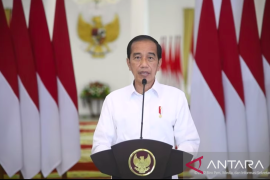The FFR, or the rate at which depository institutions lend money to one another, that is currently high, in the range of 5.25-5.50 percent, is forecast to last at least until the first half of this year.
Moreover, geopolitical tensions arising in various regions around the globe have yet to signal any immediate conclusions.
Meanwhile, China's economic growth had yet to reach the expected level on account of a property crisis and weakening consumption power. This trend will also contribute to the slowing down of the global economy and threaten the stability of the global financial system.
Amid global uncertainties, Indonesia's financial system remains resilient and stable. This financial resilience is reflected in several aspects, including adequate liquidity, decreasing credit risks, potent capital, and a sound level of corporate resilience.
In 2023, Indonesia's economy stood strong despite facing threats posed by global economic slowdown and rising global inflationary pressure, as evidenced by the country's success in achieving an economic growth rate of 5.05 percent.
This feat was a result of the intensification of government spending at the end of the year as well as the acceleration of the development of several national strategic projects.
Moreover, Indonesia's ratio of non-performing loans was capped at 2.19 percent as of December 2023, a decline of 2.44 percent as compared to the previous year.
In the household sector, the credit risk has been maintained at a good level owing to fiscal incentive policies and increased income that led to a stable debt service ratio (DSR), which reflects solid repayment capacity.
Despite the favorable trend, banks continued to strengthen risk mitigation by setting impairment loss reserves and capital adequacy ratio at relatively high levels.
According to Deputy Governor of Bank Indonesia (BI) Juda Agung, the growth of banking credits in Indonesia has continued to show progress.
In February 2024, the growth stood at 11.28 percent year-on-year (yoy) owing to positive trends in the availability of banking liquidity and credit demands from business entities as well as a preferred ratio of liquid assets to third-party funds of 27.41 percent.
Liquid assets, including state securities and rupiah securities of BI, could serve as resources of liquidity in credit transactions.
Amid global uncertainties, Indonesia's credit growth this year is projected to lie in the range of 10-12 percent alongside the normalizing growth of third-party funds and adequate banking liquidity.
Furthermore, the resilience of non-bank financial institutions, such as financing companies, lending financial technology (fintech) companies, pawnshops, and venture capitals is well maintained, as reflected in the good conditions of capital and well-controlled financing risks.
In addition, insurance and pension funds have continued to demonstrate positive performance, while the potential of spillover risk from non-bank financial institutions to banks is relatively low.
Meanwhile, corporate resilience has been sustained by well-maintained repayment capacity and debt at risk (DaR) ratio as well as the improving probability of default (PD).
Indonesia's success in keeping its financial system stable is also supported by payment system policies, the deepening of the money market, as well as Bank Indonesia's initiative to promote inclusive and green economies through policy mixes.
Bank Indonesia has been consistently mixing monetary policies and macroprudential policies to maintain stability in tandem with stimulating economic growth
The central bank's policy mixes are backed by innovation, synergy, and coordination between the central bank and the government, related authorities, and strategic partners.
Hopes for continued growth
The prolonged tightening monetary policies of major economic powers and high inflation rates have become challenges to central banks around the globe.
Under these conditions, the global economy is projected to grow at a modest rate of just three percent this year. Meanwhile, Indonesia's economy is expected to continue to record positive performances, with the growth rate reaching 4.7-5.5 percent.
The increasing expectation of economic growth, well-controlled inflation, conducive interest rates, and ongoing development of national strategic projects have given rise to optimism about the continued growth of credits in Indonesia.
As financial intermediary institutions, banks are expected to remain resilient, supported by low credit risks and strong capital.
In terms of demands, corporate financing will continue to rise along with better prospects of economic growth. Additionally, resilient household consumption will contribute to an increase in consumer credit demands.
Speaking of an inclusive economy, credits involving micro, small, and medium enterprises (MSMEs) will grow alongside the improved performance of such enterprises and the continuation of the People's Business Credit (KUR) Program in 2024.
The projected positive trends, in turn, will stimulate credit growth to reach 10-12 percent this year and 11-13 percent in 2025.
Improved performances of financial intermediary institutions will help Indonesia navigate ongoing global uncertainties, keeping its financial system stable and resilient.
Indonesia's capability of maintaining its economic growth will affirm that all policies and instruments devised are instrumental in protecting the economy from negative trends at the global level.
Related news: Indonesia's financial system maintained well in 2023: Minister
Related news: BI aims to bolster cybersecurity to protect national financial system
Translator: Martha Herlinawati, Tegar Nurfitra
Editor: Anton Santoso
Copyright © ANTARA 2024










